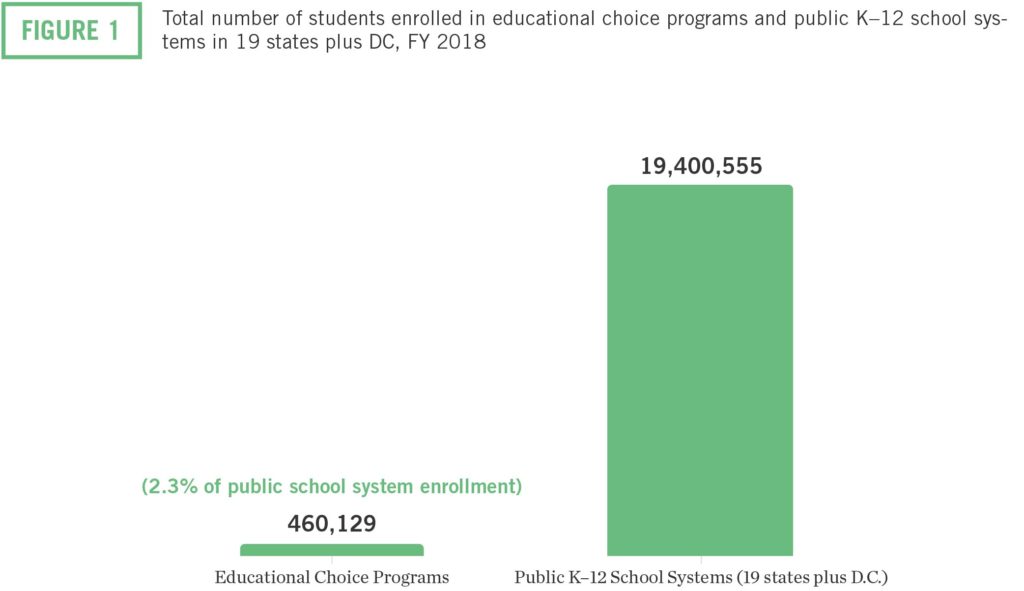NEW RESEARCH: The Costs and Savings of Educational Choice Programs in the U.S.
Today, EdChoice released a new report: Fiscal Effects of School Choice: Analyzing the costs and savings of private school choice programs in America. In this national study, I estimated the fiscal impact of 40 education savings account (ESA), voucher and tax-credit scholarship programs.
While past reports have estimated the short-run fiscal effects of these programs, this new analysis also provides estimates for long-run effects as an upper bound. This methodological update is warranted given that many programs have been operational for decades now. I also provide contextual information related to public funding gaps between educational choice programs and public schools.
Given the preponderance of claims that such programs drain money, and that even a massive influx of cash into the public school system likely won’t moderate critics from continuing to make these assertions, this report is intended to help inform policymakers about how introducing and expanding educational choice programs can affect taxpayers in their states.
Here are the key takeaways from the study.
- Through fiscal year 2018, educational choice programs generated fiscal benefits estimated between $12.4 and $28.3 billion. That’s between $3,300 and $7,500 for each student who participates in these programs. Given that most of these programs were in operation for at least five years over the study period, fiscal effects are likely closer to the long-run estimates.
- Put another way, school choice programs saved between $1.80 and $2.85, on average, for each dollar spent on these programs.
These savings happen because many of the students who use choice programs would have been enrolled in a public school if the programs did not exist—and it costs taxpayers a lot more if students go to public schools compared to school choice programs. (And more often than not, the students using school choice programs feel they’re getting a better education for their needs.)
The savings these programs generate are intuitive when one compares gaps in public funding between choice programs and public school systems.
The average cost to taxpayers for expanding educational opportunities for families is, on average, about $5,000 per student participant. The average cost to educate the same students in public school systems is nearly triple that—about $14,000 per student. This implies a 64 percent markdown for students in choice programs.

To be clear, we at EdChoice believe in a uniform system of funding children’s education where the student’s needs, rather than the type of school or educational setting they enroll in, should determine funding for their education. That is, all dollars should follow students to the educational setting of their families’ choosing. This is beside the point, though. The funding gaps are enormous and imply that savings accrue to taxpayers when students choose to leave the more expensive sector via a choice program.
Another concern people often express is that these programs could dismantle public schools by leading to an exodus of students. So what really happens after decades of programs being introduced and expanded across the country?
Well, it looks less threatening than critics might have you think: Just 2 percent of publicly funded K-12 students in states that have private school choice programs actually participate in them. The public school system, by far, remains the dominant provider of education.


Furthermore, those programs receive just 1 percent of the public funding devoted to K-12 education. So private school choice programs enroll just 2 percent of students and receive 1 percent of funding.
Of course, the important question policymakers should ask is: What effects do these programs have on students and others? The preponderance of research indicates benefits to students, families, communities and even students who remain in public schools. These benefits should not be ignored.
In light of these facts, it is challenging to see how expanding educational options for families might harm public school systems. Policymakers in states that introduce bills to create or expand choice programs can be confident that expanding educational options will not harm public school systems financially and benefits students who remain in them. There’s a mountain of evidence to support this: Not only do taxpayers benefit, but school districts have done so well coping that the students who remain are better off.
Want to dig deeper into the state of finances in American K-12 public education? Visit our Fiscal Research and Education Center (aka FREC) for more data dashboard tools, research and special resources.


